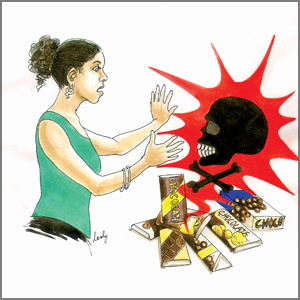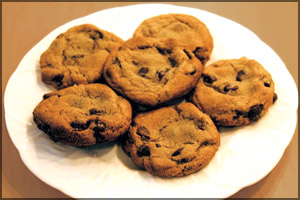
The melamine scare
Lionel WIJESIRI
The Melamine contamination scandal reported from China has rocked the
world. Sri Lankans, too, have begun to talk about melamine.
Particularly, after the Swiss authorities ordered the withdrawal from
shops of a Sri Lankan brand of biscuits on suspicion that traces of the
chemical were found in them, the interest increased further. The
producers withdrew the stocks from the local shelves pending the results
of a test report from Singapore.
 Meanwhile,
it was reported that the Sri Lankan health authorities are keeping a
vigilant eye on the food imports and have now enhanced their
surveillance of all imported food stuff into the country. The imported
Food Inspection Unit of the Food Administration Unit under the Ministry
of Health screening all imported milk food and its related food items
have deployed its food inspectors to check whether the stocks contain
melamine in any of these imported food stuff. Meanwhile,
it was reported that the Sri Lankan health authorities are keeping a
vigilant eye on the food imports and have now enhanced their
surveillance of all imported food stuff into the country. The imported
Food Inspection Unit of the Food Administration Unit under the Ministry
of Health screening all imported milk food and its related food items
have deployed its food inspectors to check whether the stocks contain
melamine in any of these imported food stuff.
Chronic exposure may cause cancer
or reproductive damage. It is eye,
skin and respiratory irritant." Not something you would want in
your infant's milk! |
Melamine is traditionally used to create durable kitchen utensils. It
is prized for its durability and during the 1950s was used to produce a
wide range of brightly coloured dishware, bowls and containers. The
compound is still used to create utensils and dishware and is used to
create a resin coating for wood and textiles. Some flame-retardants,
fertilisers and dyes also contain melamine.
Malamine can be found in some form in many urban Sri Lankan homes.
However, since lately melamine has been used to produce consumable
products. The results have been disastrous. In September 2008, nearly
53,000 infants in China fell ill after the compound was found in baby
formula and milk products.
It all started in 2007 when US investigators in detected the presence
of melamine in pet food sold in their country after owners began
complaining their pets were falling ill and unexpectedly dying. Pet food
manufacturers later said wheat gluten and rice protein imported from
China were spiked with melamine. In the same year, Canadian and U.S.
health officials began testing fish samples after finding farmed fish
had been given feed bulked up with melamine.
Technically, what is melamine?
 Composed
of nitrogen, carbon and hydrogen, the compound was invented in the 1830s
by a German scientist and came into fashion as a material used to make
plastics and laminates in the late 1930s. When combined with
formaldehyde and exposed to extreme heat, melamine creates a moldable
material that, when cooled, is virtually unbreakable and
dishwasher-safe. This made it the durable dishware of choice of
worldwide markets. Composed
of nitrogen, carbon and hydrogen, the compound was invented in the 1830s
by a German scientist and came into fashion as a material used to make
plastics and laminates in the late 1930s. When combined with
formaldehyde and exposed to extreme heat, melamine creates a moldable
material that, when cooled, is virtually unbreakable and
dishwasher-safe. This made it the durable dishware of choice of
worldwide markets.
Melamine is an organic compound, a base with chemical formula C3H6N6.
It forms a white, crystalline powder, and is only slightly soluble in
water.
It is used in fire retardants in polymer resins because its high
nitrogen content is released as flame-stifling nitrogen gas when the
compound is burned or charred.
Indeed, it is this high nitrogen level - 66 per cent nitrogen by mass
- in melamine that gives it the analytical characteristics of protein
molecules. It is described as being harmful: "Harmful if swallowed
inhaled or absorbed through the skin. Chronic exposure may cause cancer
or reproductive damage. It is eye, skin and respiratory irritant." Not
something you would want in your infant's milk!
But as melamine experienced a resurgence in kitchens, the material -
in powdered form - has also come into use by certain unscrupulous food
companies as a cheap and abundant filler substance for products ranging
from livestock feed to pet food - and now, apparently, to baby formula.
In some tests used to determine the nutritional value of a foodstuff,
melamine shows up as a protein - so manufacturers can use the compound
to make their products appear more nutritious.
In China, where adulteration has occurred, water has been added to
raw milk to increase its volume. As a result of this dilution the milk
has a lower protein concentration. Companies using the milk for further
production (e.g. of powdered infant formula) normally check the protein
level through a test measuring nitrogen content. The addition of
melamine increases the nitrogen content of the milk and therefore its
apparent protein content.
Addition of melamine into food is not approved by the FAO/WHO Codex
Alimentarius (Food Standard Commission), or by any national authorities.
In the present event, according to FAO, melamine contamination has
been found in a number of different brands of powdered infant formula,
in one brand of a frozen yogurt dessert and in one brand of canned
coffee drink. All these products were most probably manufactured using
ingredients made from melamine-contaminated milk.
Health effects
 While
there are no direct human studies on the effect of melamine data from
animal studies can be used to predict adverse health effects. Melamine
alone causes bladder stones in animal tests. When combined with cyanuric
acid, which may also be present in melamine powder, melamine can form
crystals that can give rise to kidney stones. While
there are no direct human studies on the effect of melamine data from
animal studies can be used to predict adverse health effects. Melamine
alone causes bladder stones in animal tests. When combined with cyanuric
acid, which may also be present in melamine powder, melamine can form
crystals that can give rise to kidney stones.
These small crystals can also block the small tubes in the kidney
potentially stopping the production of urine, causing kidney failure
and, in some cases, death.
Responding to concerns about the presence of the contaminant melamine
in numerous foods made in China, the Food and Drug Administration of USA
said that consuming a very small amount of the chemical poses no serious
risk. The exception, officials said, is melamine in baby formula, which
has sickened more than 54,000 infants in China. The agency said it was
unable to determine what a safe amount of melamine in formula might be.
The FDA set 2.5 parts per million as the maximum "tolerable" amount
of melamine that could be safely consumed in other foods.
"It would be like if you had a million grains of sand and they were
all white, and you had two or three that were black, that's kind of the
magnitude," said Director of the FDA's food safety program.
So what can we, as citizens, do about this situation? An expert gave
an advice as quoted in a recent Sunday Observer edition.
"Though we are away from the risk of consuming melamine contaminated
milk powder, the best advice that we can give for the consumers is to
drink fresh milk until the allegation about melamine laced milk powder
issue is resolved. Fresh milk is safer and it will help to popularise
fresh milk." |



